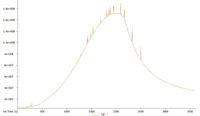Analysis of Chloroparaffins using Comprehensive Two-Dimensional Gas Chromatography
LECO Application Note
LECO European Technical Centre (ETC), Separation Science, Mönchengladbach, Germany.
Introduction
Recently there has been considerable interest in the analysis of Chloroparaffins (CP) in environmental samples. CPs are alkane chains of several lengths (C10–C30), which also have differing numbers of chlorine molecules substituted along their length (30–70%). The CPs can be divided into three groups based on their chain length; firstly, short chain CPs of C10–C13; secondly, medium chain CPs of C14–C17; and finally the long chain CPs of C17–C30.
The first group is toxic and causes a high risk for the environment and to human health. Traditional analysis of CPs using gas chromatography (GC) is a challenging task, especially since these compounds also interfere with and affect the analysis of polychlorinated biphenyls (PCBs). This fact means complex sample preparation is required to separate these types of substances before analysis is performed. Furthermore, the CPs and the PCBs have to be measured by two different analytical systems in order to provide a qualification and quantification result.
Here we describe the faster and more efficient single analysis of CPs and PCBs together. This was achieved by taking advantage of the comprehensive two-dimensional gas chromatographic technique using the LECO GC×GC–μECD system and LECO ChromaTOF software platform.
Instrument Method parameters
LECO GC×GC–μECD — fully integrated thermal quad jet modulator and 2nd dimension oven with independent temperature and operational control using the LECO ChromaTOF software.
1D column: 40 m, 180 μm, 0.18 μm Rxi-PCB; 2D column: 1 m, 100 μm, 0.1 μm Rxi-17Sil
Injection volume 1 μL
Constant flow 1 mL/min Helium
Data acquisition rate 50 Hz
Modulation period 4 sec
Comparison of GC–μECD and LECO GC×GC–μECD
The one-dimensional chromatographic separation shows a 100% coelution of chloroparaffins (CPs) and PCBs (Figure 1). It is not possible to perform a qualification or quantification of the CPs using the GC–μECD separation. Methods were transferred and adapted for use with the LECO GC×GC–μECD comprehensive system. Figure 2 shows the chromatographic separation of CP and PCB (base slice) when employing GC×GC techniques. Complimenting this, Figures 3 and 4 show how the PCBs and CPs are separated due to the difference in polarity which is made visible in the contour and surface plots from the ChromaTOF software. Using a comprehensive 2D approach, chromatographic separation of the PCBs and CPs in the same sample analysis was therefore possible.

Figure 1: GC-μECD chromatogram of the chloroparaffins (C10âC20) and PCB-mixture.
Conclusions
It is not possible to separate CP and PCB compounds using conventional GC–μECD in a single analysis. Complex and time consuming methods must be used for sample clean-up and preparation. By using the LECO GC×GC–μECD chromatographic resolution is substantially improved as are limits of detection, due to the cryofocusing effect of the thermal modulator.

Figure 2: LECO GCÃGCâμECD base peak slice of PCB 209 indicating the separation from a chloroparaffin.
A clear advantage of employing the GC×GC technique is the separation of the previously coeluting CPs and PCBs. Hence, now there is no need for complex and time consuming sample preparation when using this comprehensive approach.

Figure 3: LECO GCÃGCâμECD contour plot of chloroparaffin (C10âC20) and PCB-mixture.
Secondly, by taking advantage of the 2D features of the LECO GC×GC–μECD it is possible to accurately separate, qualify and quantify both CPs and PCBs in the same analysis. To conclude, a more efficient single analysis of CPs and PCBs is achieved saving time, money and resources.

Figure 4: LECO GCÃGCâμECD surface plot of chloroparaffins (C10âC20) and PCB-mixture.

LECO European Technical Centre (ETC)
Marie-Bernays-Ring 31, 41199 Mönchengladbach, Germany
tel. +49 2166 687 104 fax +49 2166 687 100
E-mail: SepSci@leco.de
Website: www.leco-etc.com

Analysis of Pesticides in Foods Using GC–MS/MS: An Interview with José Fernando Huertas-Pérez
December 16th 2024In this LCGC International interview with José Fernando Huertas-Pérez who is a specialist in chemical contaminants analytics and mitigation at the Nestlé Institute for Food Safety and Analytical Sciences at Nestlé Research in Switzerland, In this interview we discuss his recent research work published in Food Chemistry on the subject of a method for quantifying multi-residue pesticides in food matrices using gas chromatography–tandem mass spectrometry (GC–MS/MS) (1).
The Use of SPME and GC×GC in Food Analysis: An Interview with Giorgia Purcaro
December 16th 2024LCGC International sat down with Giorgia Purcaro of the University of Liege to discuss the impact that solid-phase microextraction (SPME) and comprehensive multidimensional gas chromatography (GC×GC) is having on food analysis.













